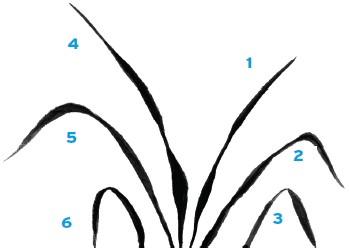Read Chinese Brush Painting Online
Authors: Caroline Self,Susan Self
Chinese Brush Painting (12 page)
This arrangement of leaves, at left, is more balanced left and right. There are four blossoms and a bud (the fifth flower) in vertical position. It has both large leaves and small, anchored leaves at the root. The picture is also grounded by light strokes representing rocks.

Practicing Orchid Leaves
Painting orchid leaves combines several strokes you practiced in the Getting Started chapter. Practice swinging your arm so you can make curved orchid leaves. This time, you also make thick and thin parts of a line. When the stroke is thin, it suggests that the leaf is twisted. Here is how you create this effect.
1.
Load a large brush with the darkest paint mix and test it on the mixing plate to make sure that it is dark. Use hand position #1.
2.
Stroke 1.
Take a breath (TAB) and place the brush at the bottom center of the page. Swing your arm upward and to the right. As you go, lift the brush slightly to make the line thinner, press again to make the line thicker, and lift the brush to taper the end of the line as you let out the breath (LOB).

3.
Stroke 2.
Make the second stroke to the right of the first one using the same technique. This time, curve the line downward when you press after the first lift.
4.
Stroke 3
.
For the third stroke to the right, make the leaf shorter and more tightly bent.
5.
Strokes 4–6.
T
ry doing the same types of strokes to the left. This may be more difficult if you are right-handed. Keep practicing swinging your arm, lifting, pressing, lifting again, and making the stroke look like a twisting orchid leaf.

Painting Orchid Leaves
The exercise for painting orchid leaves follows the principles for arranging orchid leaves. This example with five leaves includes a tall, main leaf (1), another large leaf crossing the dominant leaf making a Buddha’s eye (2), a leaf curving to the left (3), and two other smaller leaves on the right, one curving upward (4) and one bending to the right and downward (5).
Principles for Arranging
Orchid Leaves
Use an odd number of leaves, such as 5 or 7, and plan where flowers could fit between them. Allow for an odd number of flowers between the leaves, such as three flowers or two flowers and a bud. Some teachers say to paint the flowers first and then add leaves. However, for beginners, it is much easier to place the leaves correctly in the design first and then add flowers.
Make each leaf different in size and direction. One of the leaves should be longer and stronger as a main leaf. Smaller leaves can be made more curved.
Alternate leaves so that some go to the left and others go to the right.
You can let one leaf cross over another to make an opening between the leaves, a Buddha’s eye.
1.
Mix a very dark, almost black paint, which is traditional for orchid leaves.
2.
Load a large brush with the very dark mix and roll the brush against the dish to align the hairs to make a nice point. Hold your hand in position #1.
3.
Leaf 1
.
With the tip of the brush, start at the root of the plant and take a breath (TAB). Swing your arm up slightly to the right and press, lift, press and stroke upward and to the right, letting out the breath (LOB) as you lift and finish the stroke.
4.
Leaf 2
.
Start at the root again, TAB, stroke upwards to the left of the first stroke, swing your arm to the right, lifting as you cross over the first stroke, press again as you bend the stroke downward, and LOB as you lift the brush.
5.
Leaf 3
.
Reload the brush with dark paint. Start near the root, TAB, press and swing your arm upward and to the left, lifting to make a thin stroke, then curve downward with a broader brush and LOB as you lift the brush.
6.
Leaf 4.
Start at the root, TAB, and swing up and to the right slightly as you let out the breath.
7.
Leaf 5.
Start near the root, TAB, swing your arm up to the right, press and lift, curve your arm and brush, press and move downward, and lift as you let out the breath (LOB).
8.
Try painting this plant again to improve your leaves.
Painting Orchid Flowers
The flower has three types of parts:

An orchid flower is usually painted with five petals: two short, dark ones and three long, lighter ones that all meet at the center of the flower. The three stamens at the center are called “the heart” because their shape resembles the calligraphy for the word “heart.”
Painting the Short, Dark Petals


